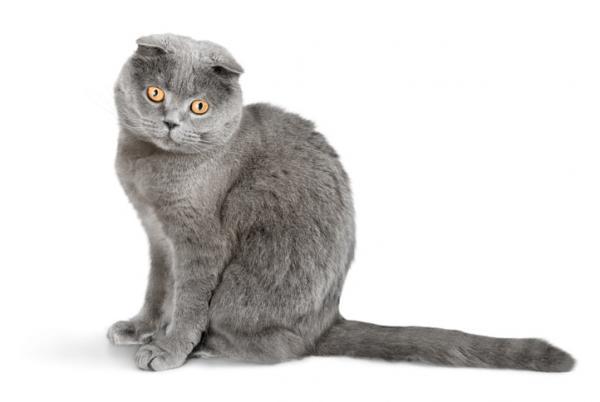Scottish fold cat: Breed Personality, Behavior Facts and Characteristics, Health Care Info

Famous in the whole world, the scottish fold or Scottish cat He is known for his adorable fallen ears and his tender gaze. Famous personalities such as Ed Sheeran and Taylor Swift have decided to incorporate cats of this breed to their families. This is, no doubt, because in addition to its magnificent appearance, it is a quiet, sociable and really affectionate animal. In we will discover more information about this precious and particular race with this article, so read on, know the characteristics of the scottish fold and let yourself fall in love for its sweetness.
Origin of the scottish fold
Datada 1966 alone first scottish fold breed cat of the story was called Susie, being she, raised by Scottish farmers, the forerunner of the current race. A local pastor decided to cross it with british shorthair cats in the year 1961, being born copies with the same particularity that its mother, the folded ears, of there the name of the race: “scottish” by its nationality and “fold”, that in English means “fold”.
However, it was not all that easy, since Susie’s direct descendants presented serious problems of arthritis and deformities, which is why the race was banned and the records of it were withdrawn in the 1971 year. With the passage of time and thanks to the intervention and hard work of geneticists and breeders, it was possible to put an end to these health problems and the scottish fold breed was restored and officially recognized by the CFA (Cat Fancy Association) 1974 alone.
Currently, it is a world-recognized breed, but the prohibition of crossing two Scottish fold specimens is maintained due to the health problems that consanguinity would cause for the offspring.
Physical characteristics of the scottish fold cat
The compact and robust body, the exotic scottish fold cats are muscular and of medium size, weighing Between 2 and 6 kilograms, and measuring from 15 to 20 centimeters of height the females, and from 20 to 25 centimeters the males. The longevity revolves around the 10-15 years of age.
His head is undoubtedly the most particular in terms of characteristics of the scottish fold is concerned, starting with his small ears folded down, which constitute the distinctive feature of the race. The face is broad and rounded, with large eyes and also round, which make them present a tender and childlike look. His cheekbones are slightly pronounced and his nose is flat and short.
Moreover, Scottish fold cat hair is dense and soft, that isolates it from the cold. Traditionally it is short hair, although there is a variety with semi-long hair called highland fold. Allowed all colors and colourpoint varieties except the one containing white.
Character of the scottish fold cat
The character of the scottish fold is tender and friendly, honoring its sweet appearance. The race is characterized by being Sociable and calm, ideal to live with both children and other animals, as it adapts perfectly to them and is also a cat quite patient and attentive.
Following in that line, our scottish fold will enjoy much of the moments of games and pampering that we provide, its main problem being loneliness, as they are animals that They need our love to stay healthy and happy. Therefore, it is not a breed of cats recommended for those who spend a lot of time away from home, as they can not stand being alone for long periods of time. In case of needing to leave, we can review the “10 games to entertain a cat” more effective.
The Scottish cat loves to play, but it is quiet by nature, a fact that combined with its Attentive and caring character it makes it ideal to accompany elderly people or with limited mobility, providing them with love and companionship without demanding too much effort in their education, since it is extremely rare for a scottish fold to make mischief or provoke destruction at home.
Scottish fold cat care
In general, scottish fold cats do not need special attention beyond the brushing your fur from 2 to 3 times per week, since its mantle is dense. If we combine brushing with products such as malt we will more effectively avoid the formation of hairballs in our feline’s digestive tract.
If you want to feeding, another care Scottish fold to which we must pay more attention, there is a factor to consider and it is the contribution of calcium. We have to look for a food with low contribution of this mineral, since the excess of it can cause the cartilage of their ears to strengthen and lose the fold that characterizes them. Anyway, the veterinarian will be the one who will recommend us about this topic and will indicate the best food for the scottish fold.
Another factor to consider in terms of their ears is that the fold they present can favor the appearance of mites and ear infections such as otitis. To avoid this, we must seek advice from the veterinarian and apply the appropriate products for the cleaning and maintenance of your ears. It is recommended to clean them at least once a week.
Removing these specific cat care scottish fold, as in all other races is recommended to be attentive to the state of mouth, eyes, nails, fur and general physical condition, as well as perform cleaning and maintenance thereof with the appropriate frequency. If we are attentive to all this, we follow the vaccine guidelines and perform the relevant deworming, we will enjoy a cat with enviable health and character.
Scottish fold cat health
The scottish fold are animals that despite not having bad health need special attention due to its genetics. We should not be scared by it, since at the moment the race does not present the serious anomalies that could occur in its beginnings, even so we must be attentive and make frequent veterinary checks to detect the problems as soon as possible or even avoid it if possible.
One of the most frequent pathologies of the scottish fold breed is otitisTherefore, we must strictly follow the indications of our trusted veterinarian to keep your ears healthy and prevent both this and other related diseases. Surely we are recommended to monitor the state of the ears and perform weekly cleanings with the appropriate products, which keep our cat healthy and free of discomfort, avoiding complications.
Due to the high consanguinity existing in felines of the scottish fold breed, these can present genetic anomalies such as deformities in the tail and extremities. In addition, the particular morphology of its ears favors the appearance of infections and problems of the auditory tract, which can lead to early deafness and problems associated with hearing.
However, if our scottish fold cat has been bred opportunely, that is by crossing a scottish fold with a race of erect ears, such as british shorthair or scottish straight, it should not present genetic conditions as painful as shortening of the coccyx vertebrae o severe arthritis in the extremities. These pathologies are characteristic in crosses with a high consanguinity, that is, when two pure scottish fold crosses.
In addition to the scottish fold care mentioned, we must follow the immunization schedule and perform both internal and external deworming that keep our pet free of parasites such as worms, fleas or ticks. With age, it may be necessary to carry out procedures such as mouth cleanings, that will keep the teeth in good conditions getting our cat to have good oral health.


